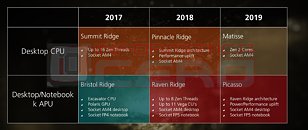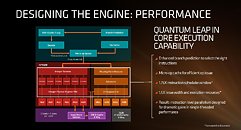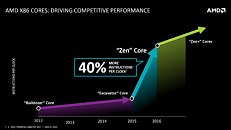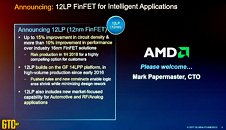Raevenlord
News Editor
- Joined
- Aug 12, 2016
- Messages
- 3,755 (1.19/day)
- Location
- Portugal
| System Name | The Ryzening |
|---|---|
| Processor | AMD Ryzen 9 5900X |
| Motherboard | MSI X570 MAG TOMAHAWK |
| Cooling | Lian Li Galahad 360mm AIO |
| Memory | 32 GB G.Skill Trident Z F4-3733 (4x 8 GB) |
| Video Card(s) | Gigabyte RTX 3070 Ti |
| Storage | Boot: Transcend MTE220S 2TB, Kintson A2000 1TB, Seagate Firewolf Pro 14 TB |
| Display(s) | Acer Nitro VG270UP (1440p 144 Hz IPS) |
| Case | Lian Li O11DX Dynamic White |
| Audio Device(s) | iFi Audio Zen DAC |
| Power Supply | Seasonic Focus+ 750 W |
| Mouse | Cooler Master Masterkeys Lite L |
| Keyboard | Cooler Master Masterkeys Lite L |
| Software | Windows 10 x64 |
AMD's Zen-based Ryzen and Threadripper have been said by the company as representing the "worst case scenario" of performance for their architecture. This is based on the fact that there are clear areas for improvement that AMD's engineers were keenly aware of even at the moment of Zen's tapping-out; inadvertently, some features or improvements were left on the chopping block due to time and budget constraints. As unfortunate as this is - who wouldn't love to have even more performance on their AMD processors - this also means AMD has a clear starting point in terms of improving performance of their Zen micro-architecture.
Spanish website Informatica Cero have gotten their hands on what they say is an exclusive, real piece of information from inside AMD, which shows the company's CPU roadmap until 2019, bringing some new details with it. On the desktop side, there's mention of AMD's "Pinacle Ridge" as succeeding the current Zen-based "Summit Ridge" Ryzen CPUs in 2018. These leverage the same Summit Ridge architecture, but with a performance uplift; this plays well into those reports of 12 nm being used to manufacture the second-generation Ryzen: it's an AMD tick, so to say. As such, the performance uplift likely comes from increased frequencies at the same power envelope, due to 12 nm's denser manufacturing design.




Another interesting tidbit from this slide is the confirmation of AMD's Zen 2 processors being released in 2019. Based on the company's revised Zen 2 cores (which should see those architectural improvements we were talking about in the beginning of this piece), AMD also seems to be doing away with the ridge-like codenames they've been using in recent times, and taking a more artistic approach. Matisse seems to be the code-name for AMD's Zen 2 architecture, and if you know your painters, it looks like AMD is betting on its Zen 2 cores to further define and influence CPU design. There is no mention of increased Zen threads, however, which likely points towards AMD keeping the same 8-core, 16-thread design as with their current Summit Ridge. This likely plays into AMD's plan for keeping the AM4 socket relevant - while good for consumers who might want to see longevity in their platform, it does prevent AMD from making more radical design changes to their architecture.

Jumping towards its notebook/desktop APU designs, AMD is looking to accompany Matisse with their code-named Picasso APUs for 2019. These should still leverage the company's upcoming Raven Ridge line of APUs, which pair Vega 11 NCUs on the graphical side of the equation and up to 8 Zen threads (4-core CPUs with SMT). However, usage of 12 nm processes across both its Zen CPU cores and Vega 11 NCUs apparently give AMD confidence that they can improve Picasso over Raven Ridge not only in the performance fields, but also the power consumption metrics.
A little bit of lore: AMD seems to be changing their code-names towards painters, and the marriage of Matisse in the CPU and Picasso in the APU space isn't a coincidence. Both artists are considered two of the most important players in the arts space of the beginning of the twentieth century, responsible for both defining and developing the arts. AMD's choice of both of them is, therefore, not a fluke; it's likely more of an artistic take on the company's vision of further defining itself as a key innovative player in the CPU space.


View at TechPowerUp Main Site
Spanish website Informatica Cero have gotten their hands on what they say is an exclusive, real piece of information from inside AMD, which shows the company's CPU roadmap until 2019, bringing some new details with it. On the desktop side, there's mention of AMD's "Pinacle Ridge" as succeeding the current Zen-based "Summit Ridge" Ryzen CPUs in 2018. These leverage the same Summit Ridge architecture, but with a performance uplift; this plays well into those reports of 12 nm being used to manufacture the second-generation Ryzen: it's an AMD tick, so to say. As such, the performance uplift likely comes from increased frequencies at the same power envelope, due to 12 nm's denser manufacturing design.




Another interesting tidbit from this slide is the confirmation of AMD's Zen 2 processors being released in 2019. Based on the company's revised Zen 2 cores (which should see those architectural improvements we were talking about in the beginning of this piece), AMD also seems to be doing away with the ridge-like codenames they've been using in recent times, and taking a more artistic approach. Matisse seems to be the code-name for AMD's Zen 2 architecture, and if you know your painters, it looks like AMD is betting on its Zen 2 cores to further define and influence CPU design. There is no mention of increased Zen threads, however, which likely points towards AMD keeping the same 8-core, 16-thread design as with their current Summit Ridge. This likely plays into AMD's plan for keeping the AM4 socket relevant - while good for consumers who might want to see longevity in their platform, it does prevent AMD from making more radical design changes to their architecture.

Jumping towards its notebook/desktop APU designs, AMD is looking to accompany Matisse with their code-named Picasso APUs for 2019. These should still leverage the company's upcoming Raven Ridge line of APUs, which pair Vega 11 NCUs on the graphical side of the equation and up to 8 Zen threads (4-core CPUs with SMT). However, usage of 12 nm processes across both its Zen CPU cores and Vega 11 NCUs apparently give AMD confidence that they can improve Picasso over Raven Ridge not only in the performance fields, but also the power consumption metrics.
A little bit of lore: AMD seems to be changing their code-names towards painters, and the marriage of Matisse in the CPU and Picasso in the APU space isn't a coincidence. Both artists are considered two of the most important players in the arts space of the beginning of the twentieth century, responsible for both defining and developing the arts. AMD's choice of both of them is, therefore, not a fluke; it's likely more of an artistic take on the company's vision of further defining itself as a key innovative player in the CPU space.


View at TechPowerUp Main Site
Last edited by a moderator:








